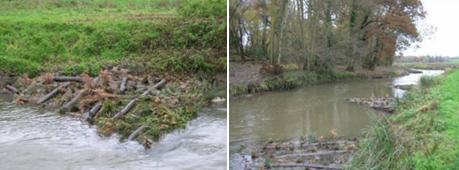Narrow water courses
Contents
- 1 Narrow water courses
- 1.1 General description
- 1.2 Applicability
- 1.3 Expected effect of measure on (including literature citations):
- 1.4 Temporal and spatial response
- 1.5 Pressures that can be addressed by this measure
- 1.6 Cost-efficiency
- 1.7 Case studies where this measure has been applied
- 1.8 Useful references
- 1.9 Other relevant information
Narrow water courses
Narrow water courses 05. River bed depth and width variation improvement
General description
In many streams and rivers, channels have been modified and widened for flood control, resulting in relatively uniform cross-sections and low water velocities and depth. As a consequence, water temperature increases during summer if shading is missing, often causing the excessive growth of aquatic vegetation, especially in nutrient rich lowland streams.
The whole channel can be narrowed, if a decrease in discharge capacity and increase in overbank-flooding can be admitted. Alternatively, if discharge capacity can not be markedly reduced, low-flow channels can be built to increase water depth and flow diversity in the given over-widened cross-section. Alternating deflectors (e.g. large wood) or berms (e.g. made of boulders) can be used to create a sinuous thalweg with higher flow velocities and water depth (similar to groynes in larger rivers). In addition, vegetation (aquatic or riparian) can be established on wing deflectors and berms to provide greater habitat diversity and shading.
Fig. 1 Narrowing of the channel using wooden wing deflectors (from Hammond et al. 2009).
Applicability
Actively building a low-flow channel, thereby further increasing discharge capacity, should only be applied in urban settings, where the potential for stream restoration is very limited. If restoration is less limited, a more natural, sinuous and deep low-flow channel can be established by natural channel dynamics. (see fact-sheets “Initiate natural channel dynamics” and “Remeander water course”). Since flow competence is low in over-widened channels, it is necessary to use flow deflectors to initiate morphodynamics.
Expected effect of measure on (including literature citations):
There is virtually no information on the hydromorphological, physico-chemical or biological effects of narrowing over-widened channels or creating a low-flow channel in peer-reviewed literature. Therefore, the assessment of the expected effect is mainly based on grey literature and expert judgement.
HYMO (general and specified per HYMO element)
Increases water depth and flow variability. Wing deflectors generally reduce channel width at low to moderate flows, defining different velocity zones (eddies and faster flowing runs), enabling the river to deposit sediment in the slow flowing zones and provide clean sediment in the thalweg (Hammond et al. 2009).
Physico-chemical parameters
No information
Biota (general and specified per Biological quality elements)
| BQE | Macroinvertebrates | Fish | Macrophytes | Phytoplankton |
|---|---|---|---|---|
| Effect | low | low to medium | low | no effect |
Macroinvertebrates: Increase of stream type specific species favouring flowing water (rheophilic).
Decrease of common (ubiquitous), tolerant (euryoecious) species favouring stagnant water (limnophilic) and often living on aquatic vegetation (phytophilic).
Fish: Increase of stream type specific species favouring flowing water (rheophilic).
Increase of larger fish due to the increase of water depth.
Increase of gravel-spawning fish (lithophilic fish) due to the increase in clean gravel substrate.
Macrophytes: Favours stream type specific macrophytes.
Phytoplankton: Probably no effect on phytoplankton
Temporal and spatial response
Pressures that can be addressed by this measure
Cost-efficiency
Low-cost efficiency due to the medium to high cost compared to the low ecological effect.
Much higher cost-efficiency if the low-flow channel develops from natural channel dynamics (lower cost and higher ecological effect) and additional measures are applied to enhance bed and bank habitats and to establish riparian vegetation.
Case studies where this measure has been applied
- Renaturierung Untere Havel
- current deflector Eichenfelde
- Freienbrink
- Stream -mending the Avon
- Blenheim Palace Project
- River Wensum Rehabilitation Project - Bintree
- Segre - Improvement of aquatic habitat of Segre River at Alòs de Balaguer
- Sweden- Restoration of the Freshwater Pearl Mussel and its habitats (LIFE04/NAT/SE/000231)
- Amesbury - Demonstrating strategic restoration and management STREAM (LIFE05 NAT/UK/000143)
- Chilhampton - Demonstrating strategic restoration and management STREAM (LIFE05 NAT/UK/000143)
- Fovant - Demonstrating strategic restoration and management STREAM (LIFE05 NAT/UK/000143)
- Upper Woodford - Demonstrating strategic restoration and management STREAM (LIFE05 NAT/UK/000143)
- Hampshire Avon - Hale
- Hampshire Avon - Seven Hatches
Useful references
[Hammond, D. Mant, J., Janes, M. & Fellick, A. (2009) River restoration assessment of the STREAM project - Executive summary. Report by the River Restoration Center (UK), unpublished, http://www.streamlife.org.uk/actions/survey/.] http://www.streamlife.org.uk/actions/survey/
River Restoration Centre: Narrowing of an over-widened channel using low cost groynes. Manual of River Restoration Techniques, Chapter 3.5. http://www.engr.colostate.edu/~bbledsoe/CIVE413/Manual_of_River_Restoration_Techniques.htm (accessed August 2010)
